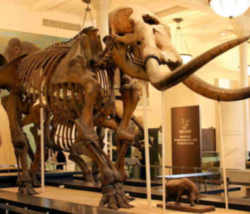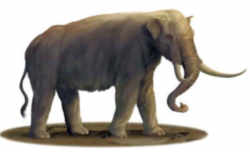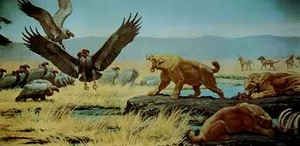Michigan State Fossil
Mastodon

(Mammut americanum)
Adopted on April 8, 2002.
In 2002, the Mastodon, (Mammut americanum,) became Michigan state fossil. Fossils of the prehistoric mammal have been found in more than 250 locations in the state.
Senate Bill 397 designating the American mastodon as Michigan's official fossil was signed by Governor John Engler on April 8, 2002. The legislation, sponsored by State Sen. Thaddeus McCotter, was the result of a long campaign by Washtenaw Community College professor Dave Thomas, Slauson Middle School teacher Jeff Bradley, their students, and other students in Wayne and Washtenaw counties.
Michigan State Fossil: Mastdon

Mastodons are part of the order Proboscidea, which also includes mammoths and other elephants. Species in this order can be immense in size, and the larger species have massive column-like limbs, a long and flexible trunk, and well-developed tusks.
Mastodons lived from the early Miocene to the Holocene (about 23 million to ~ 10,000 years ago). Between 9,000 and 12,000 years ago mastodons went extinct. Mastodons preferred to live in spruce woodlands and forests but were also found to live in valleys, lowlands, and swamps. They lived until the early Holocene, around 10,000 years ago. So far, the remains of mastodons has not usually been associated with human hunters.
Mammut americanum was an herbivore, which means it only ate plants. Mammut americanum mostly ate coniferous trees. They would eat twigs, cones, leaves, and pine needles.
Fossilized bones of mastodons have been found through out the United States. Most commonly, mastodons ranged along the Atlantic coast and south
of the Great Lakes. Their preferred habitat was open spruce woodland and forest.
The term Mammut comes from European farmers from the Middle Ages and means "earth burrower". The farmers found the massive
bones in their fields and thought they belonged to monstrous burrowing beasts.

The American mastodon (Mammut americanum) was a large, elephant-like herbivore. It ranged in height from approximately 7 feet (2.1 meters) in females,
to nearly 10 feet (3 meters) in males; an adult mastodon could weigh as much as 6 tons (5400 kilograms). Its head was equipped with a flexible trunk,
small ears, and tusks. The tusks grew straight forward, nearly parallel to one another, and curved slightly upward. Unlike modern elephants and extinct
mammoths, the mastodon had cuspate molar teeth. The name "mastodon" is a Greek derivative- mastos, "breast," and odon(t), "tooth"- that references
the animal's teeth, which have crowns consisting of distinct rounded cusps.
Mastodons were widely distributed throughout the world, and their remains are fairly common and well-preserved. Mammut americanum, the American
mastodon, ranged across North America, from Alaska to central Mexico. The species may have persisted into post-Pleistocene times, bringing them into
contact with early humans. Mastodon remains have been associated with fires, leading to the assumption that early humans hunted and ate them. Human
predation may have hastened the extinction of this species, however it is not known why the mastodons died out.
Michigan Compiled Laws
The law designating the mastodon as the official Michigan state fossil is found in the Michigan Compiled Laws Chapter 2 (STATE) Act 162 of 2002 Statute.
Act 162 of 2002 Statute
STATE FOSSIL (2.401 - 2.401)
STATE FOSSIL (EXCERPT)
Act 162 of 2002
2.401 Official state fossil.
Sec. 1.
The mastodon (Mammut americanum) is designated as the official fossil of this state.
History: 2002, Act 162, Imd. Eff. Apr. 8, 2002
Taxonomic Hierarchy: Mastodon
Kingdom: Animalia
Phylum: Chordata
Class: Mammalia
Order: Proboscidea
Family: Mammutidae
Genus: Mammut Blumenbach, 1799
Species: Elephas americanus Kerr, 1792

Some states that lack a "state fossil" have nevertheless singled out a fossil for formal designation such as a state dinosaur, rock, gem or stone.







